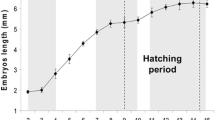Summary
Temporal relationship between the beginning of the increase of interphase duration, RNA synthesis in the nuclei and morphogenetic function of nuclei have been studied using dimensionless criteria of development duration. Experiments were performed in the trout (Salmo trutta m.fario andSalmo irideus), the whitefish (Coregonus lavaretus), the pike (Esox lucius) and the carp (Cyprinus caprio). In all these species interphase begins to lengthen approximately at the same developmental stages. The onset of morphogenetic nuclear function in the pike and whitefish coincides with the onset of interphase prolongation; in the carp RNA synthesis in the nuclei and morphogenetic nuclear function were revealed by 2τ 0 earlier than onset of interphase prolongation, and in the trout, by 5 and 13τ 0 later, respectively. Thus, a temporal disconnection between the onset of interphase prolongation, RNA synthesis in the nuclei and morphogenetic nuclear function was established for the first time. It can be suggested that the character of temporal relationship between these processes depends on the relative quantity of yolk in the eggs.
Zusammenfassung
In der Embryogenese von Forelle, Weißfisch, Hecht und Karpfen ist untersucht worden, welche zeitlichen Beziehungen bestehen zwischen dem Beginn der Zunahme der Interphasedauer, der RNS-Synthese in den Kernen und der morphogenetischen Funktion der Kerne. Bei allen genannten Arten verlängert sich die Interphase etwa in dem gleichen Entwicklungsstadium. Beim Hecht und beim Weißfisch beginnt die morphogenetische Funktion der Kerne gleichzeitig mit der Verlängerung der Interphasedauer; beim Karpfen setzen RNS-Synthese und morphogenetische Funktion der Kerne zwei Zeiteinheiten (τ 0) früher ein als der Beginn der Interphaseverlängerung, bei der Forelle dagegen 5 bzw. 13 Zeiteinheiten später. Damit ist erstmals gezeigt worden, daß kein zeitlicher Zusammenhang besteht zwischen dem Beginn von Interphaseverlängerung, RNS-Synthese in den Kernen und morphogenetischer Funktion der Kerne. Vermutlich hängt die zeitliche Beziehung zwischen diesen Vorgängen vom relativen Dottergehalt der Eier ab.
Similar content being viewed by others
References
Dettlaff, T. A.: Cell division, duration of interkinetic states and differentiation in early stages of embryonic development. Advanc. Morphogenes.3, 323–360 (1964).
—, Dettlaff, A. A.: On relative dimensionless characteristics of the development duration. Arch. Biol. (Liège)72, 1–16 (1961).
Donzova, G. V., Neyfakh, A. A.: The synthesis of high polymeric RNA in isolated blastoderms and dissociated cells of loach embryos. Dokl. Akad. Nauk SSSR184, 1253–1256 (1968).
Hansen-Delkeskamp, E., Sauer, H. W., Duspiva, F.: Ribonucleinsäuren in der Embryogenese vonAcheta domestica L. Z. Naturforsch.22b, 540–545 (1967).
Ignatieva, G. M.: On comparative-morphological approach to the analysis of inductive interactions. Cell differentiation and induction mechanisms, p. 193–202. Moscow: Nauka 1965.
—: The relative length of certain processes of early embryogeny in Salmo fish. Dokl. Akad. Nauk SSSR188, 1418–1421 (1969).
Kopsch, F.: Die Entstehung des Dottersackentoblasts und die Furchung beiBelone acus. Internat. Mschr. Anat. Physiol.18, 43 (1901).
Kostomarova, A. A., Rott, N. N.: Autoradiographic study of RNA synthesis in diploid and haploid loach embryos. Cell nucleus and its ultrastructures. Moscow: Nauka (in press).
Marrable, A. W.: Cell numbers during cleavage of the zebra fish egg. J. Embryol. exp. Morph.14, 15–24 (1965).
Neyfakh, A. A.: X-ray inactivation of nuclei as a method for studying their function in the early development of fishes. J. Embryol. exp. Morph.7, 173–192 (1959).
Oppenheimer, J. M.: Organization of the teleost blastoderm. Quart. Rev. Biol.22, 105–118 (1947).
Prakken, R., Bekendam, J., Pieters, G. A.: The chromosomes ofEsox lucius L. Genetica27, 484–488 (1955).
Richards, A., Porter, R. D.: Analyses of early development of fish embryos by means of the mitotic index. II. The mitotic index in preneural tube stages ofFundulus heteroclitus. Amer. J. Anat.56, 365–394 (1935).
Rott, N. N., Sheveleva, G. A.: Changes in the rate of cell divisions in the course of early development of diploid and haploid loach embryos. J. Embryol. exp. Morph.20, 141–150 (1968).
Author information
Authors and Affiliations
Rights and permissions
About this article
Cite this article
Ignatieva, G.M., Rott, N.N. The temporal pattern of interphase prolongation and nuclear activities during early embryogenesis in teleostei. W. Roux' Archiv f. Entwicklungsmechanik 165, 103–109 (1970). https://doi.org/10.1007/BF00650139
Received:
Issue Date:
DOI: https://doi.org/10.1007/BF00650139




